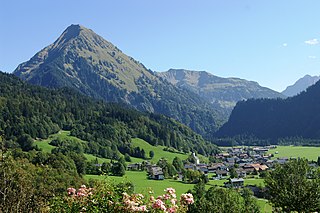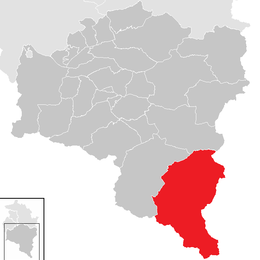
Vorarlberg is the westernmost federal state (Bundesland) of Austria. It has the second-smallest geographical area after Vienna and, although it has the second-smallest population, it also has the second-highest population density. It borders on three countries: Germany, Switzerland, and Liechtenstein. The only Austrian state that shares a border with Vorarlberg is Tyrol, to the east.

Hohenems is a town in the Austrian state of Vorarlberg in the Dornbirn district. It lies in the middle of the Austrian part of the Rhine valley. With a population of 15,200, it is the fifth largest municipality in Vorarlberg. Hohenems' attractions include a Renaissance palace dating back to the 16th century, a Jewish museum, and a charming, traffic-calmed old town center.

The Silvretta Alps are a mountain range of the Central Eastern Alps shared by Tirol, Vorarlberg and Graubünden (Switzerland). The Austrian states of Tirol and Vorarlberg are connected by a pass road. The majority of the peaks are elevated above three thousand metres and are surrounded by glaciers. Thus, the area is also known as the "Blue Silvretta".
Montafon is a 39 km long valley in the federal state of Vorarlberg (Austria) that is crossed by the river Ill (Vorarlberg). It extends from the city of Bludenz and the Verwall Alps in the north, to the Silvretta and Rätikon mountain range in the south. Piz Buin is with 3312m the highest peak within the Silvretta mountain range. The area has a population of 16.642 people.

Schruns is a municipality in the Montafon valley in the Austrian state of Vorarlberg in the Bludenz district.

Sankt Anton am Arlberg, commonly referred to as St. Anton, is a village and ski resort in the Austrian state of Tyrol. It lies in the Tyrolean Alps, with aerial tramways and chairlifts up to 2,811 m (9,222 ft), yielding a vertical drop of 1,507 m (4,944 ft). It is also a popular summer resort among hikers, trekkers and mountaineers.

Reuthe is a municipality in the Austrian state of Vorarlberg in the district of Bregenz. Its main industry is tourism.

Au is a town in the Bregenz Forest in the westernmost Austrian state of Vorarlberg.

Schwarzenberg is a municipality in the Bregenz Forest in the western Austrian state of Vorarlberg, part of the district of Bregenz. Schwarzenberg has an area of 25.76 km². It lies south of Lake Constance. The village center is heritage-protected for its traditional rustic wooden houses.

Fontanella is a municipality in the Austrian state of Vorarlberg.

Lech am Arlberg is a mountain village and an exclusive ski resort in the Bludenz district in the Austrian state of Vorarlberg on the banks of the river Lech.

Fusch an der Großglocknerstraße is a municipality, at the foot of Grossglockner mountain, in the district of Zell am See, in the state of Salzburg in Austria. The Fusch valley lies north of the main chain of the Alps. The population is 697. Fusch has an elevation of 813 metres (2,667 ft), but the maximum elevation within the municipality is 3,564 metres (11,693 ft), rising up Grossglockner mountain.

Schoppernau is a town in the Bregenzerwald Region of the Austrian state of Vorarlberg. Schoppernau has an area of 47.64 km2.

Damüls is a municipality and popular tourism resort in the district of Bregenz in the Austrian state of Vorarlberg. Damüls also holds the world record of the municipality with the most annual snowfall in Europe – the average is 9.30 meters per year. In 2006, Damüls was awarded the honorary title "the snowiest village in the world".

Doren is a municipality in the district of Bregenz in the western Austrian state of Vorarlberg.

Kennelbach is a community in the district of Bregenz in the westernmost Austrian state of Vorarlberg.

Lingenau is a municipality in the district of Bregenz in the Austrian state of Vorarlberg.

Schröcken is a municipality in the district of Bregenz in the Austrian state of Vorarlberg.

Sibratsgfäll is a municipality in the district of Bregenz in the Austrian state of Vorarlberg.

Stuben am Arlberg is a winter sports resort in the municipality Klösterle in the Austrian province of Vorarlberg. It is located at 1410 m AA and counts 90 inhabitants.

























